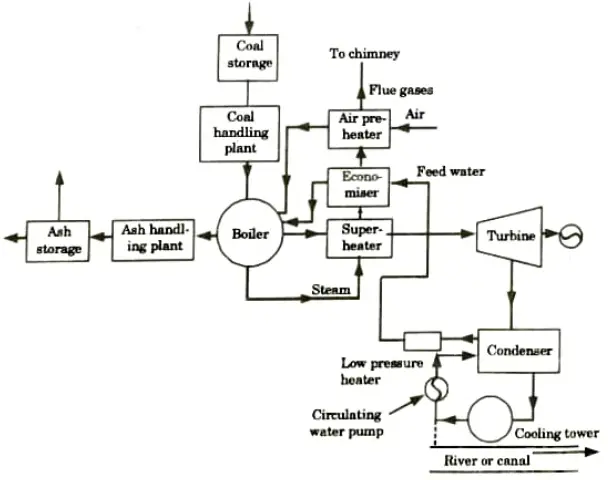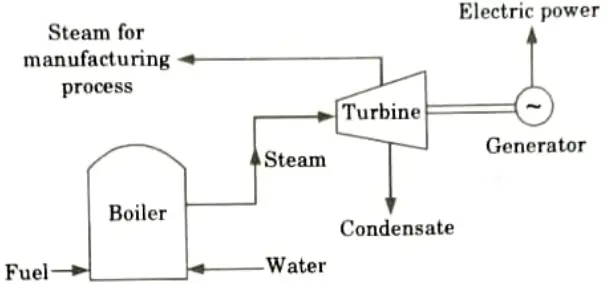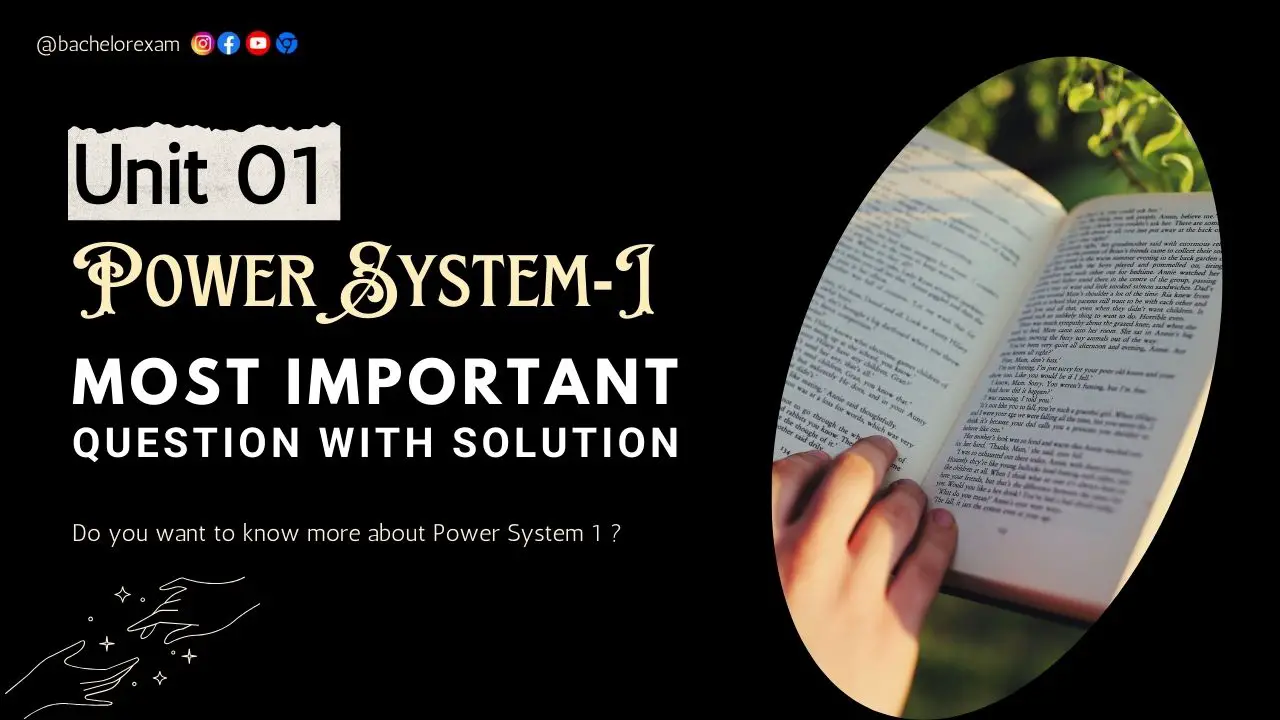Aktu Btech Quantum Notes can help you improve your understanding of Power System-I. These important, commonly asked questions can help you prepare for your exam. Improve your performance right now! Unit-1 Power Generation
Dudes 🤔.. You want more useful details regarding this subject. Please keep in mind this as well. Important Questions For Power System-I: *Quantum *B.tech-Syllabus *Circulars *B.tech AKTU RESULT * Btech 3rd Year * Aktu Solved Question Paper
Q1. Draw the basic structure of power system.
Ans. A network of electrical components is known as an electrical power system, and it is used to transmit power from power plants to final users. There are three main phases in a power system:
- 1. Generation: The place where power is generated is known as ‘power plant’ or ‘power house’.



- 2. Transmission: A power system’s transmission of electrical supply refers to the process by which electricity is transferred from one station to another.
- 3. Distribution: The portion of the power system known as distribution of power supply is where the supply is divided among the users.
Q2. Give the layout of a modern thermal power plant and explain it briefly.
Ans. The layout of a modern thermal power plant comprises of the following four circuits:
- 1. Coal and ash circuit: Coal is delivered to the storage yard, where it is handled as needed before being fed through the fuel feeding apparatus to the furnaces. Ash handling machinery removes it to the ash storage yard after collecting at the back of the boiler as a result of coal combustion.
- 2. Air and gas circuit: Through the use of a forced or induced draught fan, air is drawn in from the outside and transported to the furnace through the air pre-heater, where it is heated by flue gases that are carried to the chimney via the pre-heater.



- 3. Feed water and steam flow circuit: Heat is first applied to water and the condensed steam leaving the condenser in a closed feed water heater using steam drawn from the turbine’s lowest pressure extraction point. Before entering the boiler through the economiser, it first passes through the deaerator and a few additional water heaters.
- 4. Cooling water circuit: The condenser’s low pressure is kept in check by the cooling water that is provided to it. A natural source of water, such a river, lake, or the sea, may be used, or the same water may be chilled and circulated repeatedly.
Q3. What do you understand by load diversity ? Explain the role of the load diversity in power system economy.
Ans. A. Load diversity: It is the difference between the peak of the combined load and the sum of the peaks of two or more independent loads.



B. Role of load diversity:
- 1. A reduction in the number of generating, transmission, and distribution facilities results from the diversity between the loads of various customers and geographic areas.
- 2. The day and the year are the most important time frames to take into account diversity.
- 3. The difference between the daily load cycles in two or more adjacent load zones, which results in peaks at various times throughout the day, is what causes daily diversity. Diversifying the daily load lowers operating costs.
- 4. Economic energy transactions or daily diversity exchange agreements can be used to obtain the advantages of daily diversity.
- 5. These transactions decrease the cost of fuel and the start-up and shutdown of the unit, but they can have no impact on the capital requirements.
- 6. Yearly diversity is typically caused by a significant and enduring variance in the yearly weather and customer load requirement patterns between two or more load locations.
- 7. One system’s yearly peak load may occur in the winter, whilst another system’s peak load may occur in the summer.
- 8. In a similar vein, one system’s peak might occur in the morning while another’s might occur in the evening.
- 9. Because the installed generating capacity needs are reduced by annual load variability, capital savings are possible.
- 10. To do this, future diversity must be predicted and a choice must be made many years before the new capacity requirements.
- 11. Due to the factors that impact load diversity amongst systems, approximately 10 years of historical data are needed before projections can be made with a high degree of accuracy.
- 12. Among these variables are the temperature, the weather, the state of the economy, the time of day, the usage habits of new electric devices, etc.
- 13. The diversity analysis is a crucial component of generation capacity planning and should not be treated as a separate component as a result because it does not completely decrease the need for margins.
- 14. As a result, in order to identify an appropriate capacity and interconnection capability, all forms of diversities can be fully accounted for by combining the system loads.
- 15. The load forecasting mistake can include any variation in diversity brought on by statistical and historical analysis.
Q4. The yearly load duration curve of a power plant is a straight line. The maximum load is 500 MW and the minimum load is 400 MW. The capacity of the plant is 750 MW. Find (a) plant capacity factor, (b) load factor, (c) utilization factor, (d) reserve capacity.
Ans. Given: Maximum load = 500 MW, Minimum load = 400 MW, Capacity of the plant = 750 MW
To Find: Plant capacity factor, load factor, utilization factor, reserve capacity.



Q5. Discuss the captive power plants.
Ans.
- 1. A facility that offers a specific source of electricity to an energy consumer is referred to as a captive power plant.
- 2. Usually, these are factories, sizable offices, or data centres.
- 3. The capacity to export excess power to the nearby electricity distribution network allows the reactors to run in grid parallel mode. They might also be able to function in island mode, which would mean being independent of the local electrical distribution system.
- 4. As a type of distributed generation, captive power plants provide electricity close to the point of demand. High fuel efficiency and reduced transmission losses from centralized power plants’ electricity are two benefits of distributed generation facilities.
- 5. Gas engines can be used in microgrids in conjunction with other power generation or storage technologies.
- 6. Gas engines make ideal captive power plants where there is a localized supply of gas.
Q6. Explain the concept of cogeneration (combined heat and power).
Ans.
- 1. Cogeneration is the sequential transformation of a fuel’s energy into two or more useable forms.
- 2. Coal energy is transformed into heat in the boiler to produce steam in one manifestation. This steam also serves to heat the industrial process in addition to being used to produce electrical energy.
- 3. In a different instance, a gas turbine is employed to produce electricity. In a heat recovery boiler, the residual heat is utilised to create steam. This steam is either used as process steam for manufacturing processes or is used to produce more electrical energy.
- 4. In contrast, a cogeneration system generates both electrical and thermal energy from the same main fuel, whereas a typical system uses fuel energy to produce either (for manufacturing processes).
- 5. Compared to a cogeneration system, a traditional system requires more fuel to produce the same amount of overall energy.
- 6. An implant power generation system or a reject heat utilization system are both examples of cogeneration systems.
- 7. Fig. depicts the implant power generation used in industries. Electricity and process steam are both necessities for the sector.
- 8. In the traditional technique, a boiler produces steam, and either electricity is purchased from a utility or is created by a diesel generator.
- 9. If cogeneration is used, the boiler is made to produce steam at a higher temperature and pressure than needed for manufacturing purposes. This steam is used in a turbine generator set to produce electricity. The exhaust steam (from turbine) is used for manufacturing purpose.



- 10. Power plants employ a mechanism for using reject heat. A small amount of steam is drawn from the turbine and given to a nearby company for industrial purposes (at the proper temperature and pressure). This is shown in Fig.






Important Question with solutions | AKTU Quantums | Syllabus | Short Questions
Power System-I Btech Quantum PDF, Syllabus, Important Questions
| Label | Link |
|---|---|
| Subject Syllabus | Syllabus |
| Short Questions | Short-question |
| Question paper – 2021-22 | 2021-22 |
Power System-I Quantum PDF | AKTU Quantum PDF:
| Quantum Series | Links |
| Quantum -2022-23 | 2022-23 |
AKTU Important Links | Btech Syllabus
| Link Name | Links |
|---|---|
| Btech AKTU Circulars | Links |
| Btech AKTU Syllabus | Links |
| Btech AKTU Student Dashboard | Student Dashboard |
| AKTU RESULT (One VIew) | Student Result |
